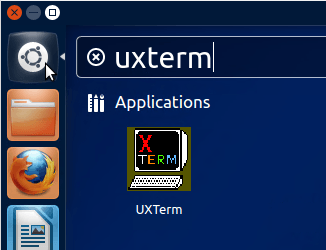

Want to skip glyph selection? No ligatures or Arabic or Devanagari text for you. Want to skip font selection? No emojis for you. line wrapping), glyph pre-rendering, and a final assembly step to get the composite image of all glyphs. kerning), glyph selection, text layouting (incl. Nowadays displaying text requires font selection, text shaping (incl. I'm currently changing mi mind for a better life in the shell, so any useful resource you want share with me or correction to me, will be received gracefully.Īlso, in the 70s, you have a bitmap font of max 256 characters of equal size.

#Uxterm settings how to
Text editing in my opinion is so slow in a GUI except for some programs like emacs, gvim and others (but whit proper extensions), and with a bit of knowledge you can achieve the same or maybe if you are persistent and develop the love for the CLI a more powerful "button" for your development environment that fits exactly your needs, and it immediately gives you more freedom, you never will to wait until the next version of your spyder or what ever IDE out there to make something you want to do, and if it fails you know how to fix it because you wrote it, that said, REPL came from "SLIME" that means "Superior Lisp Interaction Mode for Emacs", ergo, emacs users have been using REPL long time ago before, even before spyder or any "modern" IDE we actually have, that said, there is a plugin for vim too called vim-slime inspired by SLIME, where you can send words, lines, block or whole text files from your editor to other app, lets say tmux, your browser or any others, so vim, vim-slime plugin, tmux and a script to send text from your editor to shell executing python or ipython3 console or python-qtconsole gives you the REPL feature that is so acclaimed these days, and I want to say that since I implemented it for python development until now, it never crashed, so really I do not miss nothing from any IDE out there jeje, I hope some one who read this out there, expanded his main a bit and break some limitations with these little tip!. I am not an expert of *NIX OS, but in my two years of learning the philosophy of the OS I noticed that almost every implementation of a GUI concept or idea has it origin from CLI, the GUI is just a manner of automating things in a way that once you know what to write to the computer to do what you want to achieve, that task remains in the form of that button, but again in my opinion a button is just another abstraction of an "alias" in the CLI for a command or just a text file whit a script, it is useful for some cases to have buttons, for example editing a video in CLI is not a optimal choice for that task, I mean you can but probably will take you much more time, specially if you don't know the tool, but in the other hand, almost every video editing GUI app uses "ffmpeg" ( a CLI app and library) as it backed, so probably learning ffmpeg will teach you how to use almost every app of video editing out there.


 0 kommentar(er)
0 kommentar(er)
